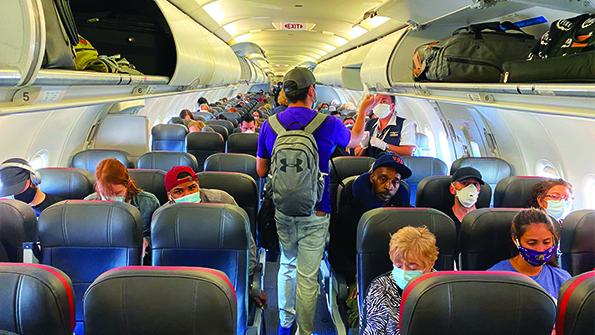オピニオン:新型コロナウィルスに対する航空各社の対応は不充分

航空各社は、6月には多くの地域でキャパシティが現実的な量に回復しつつあることで、これが回復への道筋になると望むようになってきた。経営陣は、打ち出しているキャンペーンに利用者の一部が反応し、航空旅行を再開することで、本来であればピークシーズンであるこの時期に発生している莫大な資金流出を食い止めることを期待している。
最も重要な要素のひとつは、航空旅行の安全性に対する信頼感だ。利用者は、搭乗中に新型コロナウィルスに感染する可能性が低いことを確認したい。ICAOは、検疫をせず、座席中央列を空けることもなく安全な飛行を再開するためのガイドラインを定めた。
航空会社はほぼガイドラインに対応できている。新ルールはフライトを若干不便なものにする。マスクを何時間も着用し続けることは不快だが、我慢できないほどでもない。このプロセスの他のステップが適切に守られれば、多くはマスク程度のことで必要な出張や家族でのバケーションを避けることにはならないだろう。
免責事項:以下に記す内容の一部は、6月15日の週に搭乗した4回のヨーロッパ域内線と、他の旅行者との会話を元にしている。これはとても全体像を反映したものとはいえないが、その一部として紹介する価値はあると考えている。
第1の問題は、かなりの数の利用者が新しいルールを守っていないということだ。航空旅行を再開した人の多くは、空港におけるソーシャル・ディスタンスが守られていないケースが多いことを認めている。保安検査場では守られていることもあるが、一般的には搭乗待ちの列で混乱が起きる。さらに、マスクの着用が義務づけられているにもかかわらず、それを無視する人も少なくない。
第2の問題は、ルールを厳格に徹底させられていないことだ。航空会社社員や自動アナウンスは、コロナ危機はまだ終息しておらず、適切な対応が必要であることをアナウンスしている。数週間から数ヶ月に及ぶロックダウンの後では、多くが行動制限に疲れていることは理解できる。しかし、利用者はルールに注意を払っておらず、係員もそれを充分に徹底できていない。そして、もしこれを徹底すれば、搭乗時間が非常に長引く可能性が高い。しかし航空会社が本格的に回復を始めるためには、規律を徹底させることが非常に重要だ。
また、航空会社は機内における空気の清潔さや、高性能(HEPA)フィルターの使用に関する議論に対しても積極的に発信してきた。もちろん、航空会社が利用者からの信頼を得るために、機内の安全性をPRするためにあらゆる手段を用いることは理解できる。しかし、旅客機のキャビンと手術室の清潔さを比較することはミスリードだ。
さらに、HEPAフィルターは搭乗前から機内空調システムがオンになっていない限り機能しない。業界では新しい手順を導入することになっているが、確認した限りでは、(まだ)全てのフライトで実施されているわけではない。
「機内空気の清潔さは、手術台の周りに200人の見学者が立っている手術室の空気と同等だ」と語るのは、HAWハンブルグ大学で航空機デザイン・システムグループ長を務める、Dieter Scholz教授だ。
これはもうひとつの重要な疑問につながる。座席中央列は空けておくべきなのか?航空各社は、様々な方法でこの問題に対応している。デルタ航空がもっとも明快で、ロードファクターが許容する限りは空けておくという対応だ。IATAは中央列を空けることについて「健康上のいかなるメリットにもつながらない」としており、中央列を空けることの強制について「強く反対」している。
HEPAフィルターは航空会社がアピールする通り高性能なのかもしれないが、満席の客室内で、すぐ隣にいる乗客からの感染を防ぐことはできない。密接した環境においてはFFP2規格のマスクが必要になる。しかし、現状の供給不足や医療機関に優先的に供給されるべきという事情から、欧州航空安全機関のような規制当局は乗客に対し、FFP2よりも1ランク下の医療用マスクの着用を推奨している。しかし、利用者はそれらを使うこともなく、買い物に行くときと同じようなマスクを着用していることが多い。
新型コロナウィルスと航空旅行の安全性を見たとき、感染リスクは小さいとはいえ、決してゼロではない。Scholz教授の計算によると、機内でウィルスに感染する確率は、航空機事故に遭う確率の10倍だ。
航空旅行を再開するための正当な理由は数多くあり、また同時に不安視される正当な理由も多い。判断はそれぞれの利用者が自分で下すしかない。しかし、業界は新たなルールやプロセスを導入し、それを徹底させる必要がある。そしてリスクも残されていることを明らかにし、対応を疑問視するクレームに足元をすくわれないようにする必要もあるだろう。まだまだやるべきことはたくさんある。
以上は、Jens Flottauが Aviation Week & Space Technologyいた記事です。 Aviation Week & Space Technology は、豊富な経験と人脈を持った専門家により、最新トレンドや最適な状況判断、ポリシー・要求仕様・予算に関する充実した情報を継続的にお届けします。 Aviation Week & Space Technology をもっと知りたい場合、こちらをクリックして下さい。
In June, airlines have begun what they hope is a path to recovery as capacity in many regions has increased to more meaningful levels. Executives are hoping that passengers will react to the return of some offerings and resume flying in numbers significant enough to reduce the dramatic cash outflow occurring in what would normally be peak season.
One of the most important factors is the trust that flying is safe. Passengers want to know they are unlikely to be infected with the novel coronavirus during the journey. The International Civil Aviation Organization has defined guidelines for resuming flying safely without quarantines and without forcing airlines to leave the middle seat empty.
Airlines have largely gotten it their way. Regulations are making flying a little more inconvenient for passengers. Wearing a face mask for hours may be unpleasant, but it is bearable and will not keep many from making necessary business trips or families from vacationing if all the other steps in the process are adhered to properly.
Disclaimer: Some of the following conclusions are based on four intra-European flights during the week of June 15 and conversations with other travelers. They are not reflective of anywhere near a complete picture, but they paint one that is concerning enough to write about.
The first problem is that a substantial number of passengers are not abiding by the new rules. Many who have started flying again will confirm that social-distancing rules at airports are often not being followed. The distancing may work at security lines, but the usual chaos typically ensues during boarding. Moreover, while face masks are mandatory, all too often people ignore the requirement.
The second problem is a lack of strict rules reinforcement. Airline staff and automated announcements remind people that the crisis is not over and that certain behaviors are expected. It is not surprising that after weeks or months in lockdown many are weary of limitations. Passengers are not paying attention to the rules, and staff are not reinforcing rules enough—if they did, boarding time would likely be excessive. But for aviation to start a recovery in earnest, discipline is crucial.
Airlines also have been vocal in the public debate around the air inside cabins and the use of high--efficiency particulate air (HEPA) filters onboard. Doing everything to promote the idea that flying is safe is understandable: Airlines have a high interest in regaining passenger confidence. But to compare an airline cabin to an operating room is misleading.
Additionally, HEPA filters only work throughout the journey when the air conditioning system has been turned on prior to boarding—based on evidence, that is not (yet) the case on every flight in spite of the promise by industry to introduce new procedures.
“The air quality inside an aircraft is comparable to that of an operating theater when 200 people stand around the operating table watching,” says Dieter Scholz, a professor and head of the aircraft design and systems group at HAW Hamburg University.
This leads to another crucial question: Should the middle seat be left empty? Airlines have approached the issue in different ways. Delta Air Lines has been the clearest, leaving the seat free for now as long as load factors permit. The International Air Transport Association says the seat vacancy does “not add any healthy benefit,” so it is “strongly opposed” to making empty seats mandatory.
HEPA filters may be as efficient as airlines claim, but they do not prevent you from being infected by your immediate seat neighbor in a full cabin. To compensate for the lack of spacing, FFP2 masks would be required. But given insufficient supply and the fact that the equipment is supposed to be reserved for medical personal, regulators such as the European Union Aviation Safety Agency recommend passengers use medical face masks one tier below the FFP2 standard. Passengers are not even using these—opting instead for the types of masks used for shopping.
However one looks at COVID-19 and flying, the risk of being infected, though small, is certainly not zero. Scholz calculates that it is 10 times more likely for someone to get the virus onboard than to be involved in an aircraft accident.
There are many legitimate reasons for flying to resume; there are also many legitimate reasons to be concerned. The decision is one individual travelers have to make themselves. But industry must implement rules and processes more forcefully, be transparent about the remaining risks and not be caught making questionable claims. There is more work to do.
